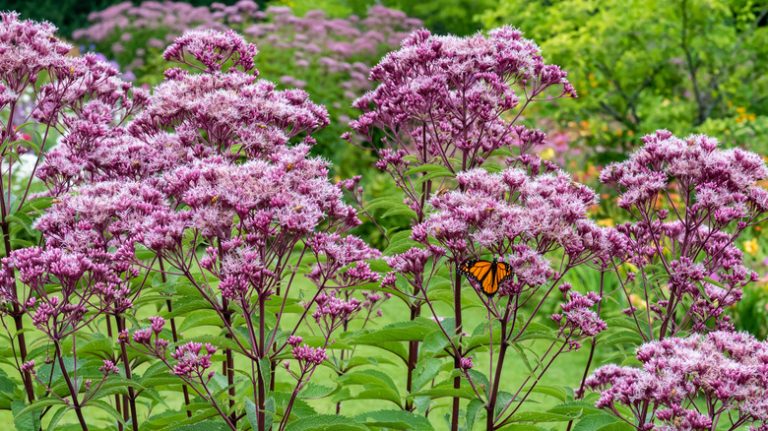If you’re a garden enthusiast, you probably know how versatile and breathtaking clematis can be. These beautiful flowering vines add dimension and color to any garden, with their large and vibrant flowers. Whether you’re a seasoned grower or just starting out, there’s a clematis variety for everyone.
One of the most popular types of clematis is the spring blooming variety. These types of clematis, like the ‘Justa’ and ‘Cezanne’, start flowering in late spring and continue to bloom throughout the season. They have beautiful violet flowers that pop against the green foliage, making them a favorite among many gardeners.
If you’re looking for something a little different, then the double bloomers might be your choice. These clematis, such as the ‘Anna Perle’ and ‘Nelly Moser’, have double-headed flowers that resemble a fountain in full bloom. They add a touch of elegance to any garden and are sure to catch anyone’s eye.
For those who prefer a more repeat blooming clematis, the ‘Royal Velours’ and ‘Fireworks’ are excellent choices. These varieties bloom not only in the spring but also in the fall, giving you more flowers and color throughout the year. They do well in both full sun and shaded areas, making them versatile additions to any garden.
When it comes to planting clematis, it’s important to choose the right type for your zone and conditions. Most clematis varieties prefer well-drained soil and sunlight for at least 6 hours a day. Take some time to research the specific care and growing needs of each type before planting, to ensure the health and longevity of your clematis vines.
With so many different types of clematis available, there’s sure to be one that will suit your garden and personal style. Whether you prefer the classic blooms of the ‘Hagley Hybrid’ or the vibrant colors of the ‘Carnaby’, clematis can add a touch of beauty and grace to any outdoor space. Don’t be afraid to experiment and try new varieties – you may just find your new favorite plant.
Check out the photos below for a visual guide to some different types of clematis:
1. ‘Justa’
2. ‘Cezanne’
3. ‘Anna Perle’
4. ‘Nelly Moser’
5. ‘Royal Velours’
6. ‘Fireworks’
7. ‘Hagley Hybrid’
8. ‘Carnaby’
All About Clematis
Clematis is a popular vine plant that adds beauty and charm to gardens. With their unique and beautiful flowers, clematis vines are a wonderful addition to any outdoor space. They can be planted in gardens, along fences, or trained to climb up an arbor or trellis. Clematis vines are long-lived and can provide years of beauty with proper care.
There are many different types of clematis, each with its own characteristics and growth habits. Some popular varieties include ‘Duchess of Edinburgh’, ‘Belle of Woking’, ‘Crystal Fountain’, ‘John Paul II’, ‘Fireworks’, ‘Tangutica’, ‘Nelly Moser’, and ‘Purpurea Plena Elegans’. These clematis varieties vary in size, color, and blooming time, allowing for a more diverse and interesting garden.
Clematis vines are known for their large and showy flowers, which can range in color from deep blues and purples to soft pinks and whites. Some varieties, such as ‘Abundance’, ‘Alaina’, and ‘Aotearoa’, feature double flowers, adding even more beauty to the garden. Clematis blooms from late spring to summer, and some varieties may repeat their blooming throughout the season.
Clematis vines are easy to care for, but they do have specific needs. They prefer full sun or partial shade and well-draining soil. Clematis vines need support for their climbing stems, so planting them near a fence or trellis is recommended. Regular watering and fertilizing will help promote healthy growth. It’s also important to prune clematis vines in late winter or early spring to remove any dead or damaged stems and encourage new growth.
When choosing a clematis variety for your garden, consider the height and growth habit of the vine. Some varieties, like ‘Cherokee’, ‘Anna Louise’, and ‘Jackmanii’, can reach heights of up to 20 feet, while others, like ‘Piilu’ and ‘Asagasumi’, stay more compact. It’s also important to plan for the space needed for the vine to spread out, as clematis vines have a wide growth habit.
In conclusion, clematis is a beautiful and versatile plant that can add a touch of elegance to any garden. With their wide range of colors and forms, there is a clematis variety to suit every gardener’s taste. Whether you prefer the more traditional and popular varieties or the unique and rare ones, clematis vines are sure to bring joy and beauty to your outdoor space.
Your Guide to Planning Planting and Growing Clematis
When planning your garden and deciding where to plant clematis, it’s important to consider the different types and their characteristics. Clematis is a beautiful flowering vine that can add color and interest to any outdoor space.
One popular variety is the ‘Cezanne’. It blooms in early spring and produces large, deep purple flowers. Another popular choice is the ‘Cherokee’. This variety blooms later in the season and has pale pink flowers.
For those who prefer a more compact clematis, the ‘Moser’ series is a great option. These late bloomers have shorter stems and are resistant to wilt. The ‘Moser’ series includes colors such as ‘Abundance’, ‘Alaina’, and ‘Asagasumi’.
If you have a fence or trellis that needs some climbing color, the ‘Bill MacKenzie’ clematis is a fantastic choice. These flowers are a vibrant yellow and will easily climb up any vertical structure.
For shaded areas, the ‘Crystal Fountain’ clematis is a great option. Its blue-purple flowers add a splash of color to the edges of any garden.
If you’re looking for a repeat bloomer, the ‘Viticella’ is a wonderful choice. These clematis produce flowers throughout the seasons and come in a variety of colors, such as ‘Carnaby’, ‘Anna Louise’, and ‘Aotearoa’.
When it comes to planning your clematis garden, keep in mind that these plants prefer well-drained soil. Make sure to choose a location with good drainage and plant each clematis about 20 inches apart to allow room for growth.
As you plant your clematis, provide some support for the vines to climb on. An arbor or trellis works well for this purpose. You can also use a fence or create a designated climbing area for your clematis.
Clematis are loved by both gardeners and butterflies alike. By planning your clematis garden properly and choosing the right varieties, you can enjoy a colorful and vibrant display of flowers throughout the seasons.
Remember to water your clematis regularly and provide them with proper care to ensure their health and beauty for years to come.
Start with a Better Plant
When it comes to growing clematis, starting with a high-quality plant is essential. By choosing a well-established and healthy plant, you will have a better chance of success in your garden. With so many clematis varieties available, it can be overwhelming to know which one to choose. Whether you are a beginner or an experienced gardener, there are a few key factors to consider when selecting the right clematis plant.
First, it’s important to know that clematis fall into different groups based on their blooming times and pruning requirements. Some varieties, like the early spring bloomers, bloom on the previous year’s growth. Others, like the late bloomers, bloom on the current year’s growth. This means that pruning times can vary depending on the type of clematis you have.
Secondly, you should consider the size of the plant and its growth habit. Some clematis varieties can reach up to 20 feet in height, while others are more compact and suitable for smaller gardens. Think about the available space in your garden and choose a plant that will fit well.
Another important factor to consider is the flower color and shape. Clematis come in a wide range of colors, from soft pastels to vibrant hues. They also have varying flower shapes, from delicate bell-shaped blooms to larger, showier heads. Choose a variety that complements your garden’s color scheme and suits your personal preferences.
In addition to the flower color and shape, pay attention to the foliage of the clematis plant. Some varieties have unique foliage patterns that add visual interest to the garden, even when the plant is not in bloom. Others have more muted foliage that allows the flowers to take center stage. Consider what type of foliage you prefer and choose a plant accordingly.
Lastly, think about the purpose of your clematis plant. Do you want it to climb a fence or trellis? Or do you prefer it to grow and create a soft backdrop for other plants? Knowing the purpose of your clematis will help you choose the right variety for your needs.
| Variety | Bloom Time | Color | Height |
|---|---|---|---|
| ‘Josephine’ | Late spring to early summer | Pink | 8-12 feet |
| Viticella ‘Alaina’ | Summer to early fall | Purple | 6-10 feet |
| ‘Asagasumi’ | Summer | Pink with darker edges | 10-12 feet |
| ‘Aotearoa’ | Summer | Pink with a touch of violet | 6-8 feet |
| ‘Diamantina’ | Late spring to early summer | Blue | 8-12 feet |
| ‘Cherokee’ | Spring | White | 6-8 feet |
| ‘Crystal Fountain’ | Summer to early fall | Light blue | 6-8 feet |
| ‘Chantilly’ | Spring | White with violet center | 8-10 feet |
With all these factors in mind, you can confidently choose a clematis plant that will thrive in your garden. Remember, starting with a high-quality plant is the first step towards success in growing clematis.
Plan for Success
When planning to grow different types of clematis, it is important to have a well-thought-out plan for success. Here is a guide to help you get started:
- Decide on the number of plants you want to grow. A rule of thumb is to plant about 20 clematis per 100 square feet.
- Choose the right varieties for your garden. Some popular clematis types include ‘Perle d’Azur’, ‘Abundance’, ‘Piilu’, ‘Crystal Fountain’, ‘Royal Velours’, ‘Justa’, and ‘Josephine’.
- Consider the blooming time of each variety. There are early bloomers, mid-season bloomers, and late bloomers. It’s a good idea to have a mix of different types to ensure a continuous display of flowers throughout the growing season.
- Find out the height that each variety will reach. This will help you plan where to place the plants in your garden for optimal visual impact.
- Make sure you have a suitable location for planting. Clematis prefer a sunny spot with well-drained soil.
- Purchasing high-quality plants is crucial for success. Look for healthy-looking plants with well-developed roots.
- Choose a suitable support structure for your clematis. Some varieties, like the Jackmanii group, can climb up to 12 feet, while others, like the Viticella group, only reach about 6 feet.
- Plan for proper care, including watering, fertilizing, and pruning, based on the specific needs of each type of clematis. Refer to a reliable gardening resource or consult a local expert for guidance.
- Enjoy the beauty of your clematis as they start blooming. You can expect these long-lived plants to grace your garden with an abundance of colorful flowers, attracting butterflies and adding charm to your outdoor space.
By following this plan for success, you can ensure that your clematis plants thrive and provide a stunning display of flowers throughout the season. With proper planning and care, you can enjoy the beauty of these versatile and beautiful climbers in your garden.


